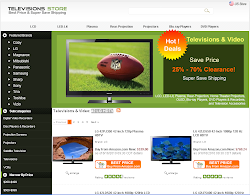If your main purpose is to use an LCD display as computer monitor, the additional cost of the features of an LCD television, such as a built-in analog or HDTV tuner, analog AV and HDMI inputs, and other features needed for television-like performance, may be extra things you may not need.
In addition, if you are a gamer or have your PC integrated into your home theater system, and want the largest possible monitor to play on and show off to your friends, a 30-inch LCD television can be a very impressive computer monitor. If you are planning to use your LCD TV as both a television and computer monitor, make sure the unit you're considering does have VGA or other connection options designed for PC use.
If you're planning to have one, there are a lot of models available in the market today. Here are some of the top and hot LCD's in the market:
Sony Bravia KDL-40V2500 40-inch 1080p LCD Television.
The Sony KDL-40V2500 is a 40-inch 16x9 LCD television with a native pixel resolution of 1920x1080 (1080p) and a real world contrast ratio of 1,300:1. This set also includes 2 HD-Component and 2 HDMI video inputs, as well as a PC monitor connection. NTSC, ATSC (HDTV), and QAM tuners are also included. The ATSC tuner allows reception of the over-the-air HDTV signals and the QAM tuner allows Digital/HD-cable (non-premium channels) reception. The detail, color consistency, and contrast, on this LCD television is great. Check out the Sony KDL-40V2500, especially if you have a Blu-ray, HD-DVD, or upscaling DVD Player.
Samsung LN-T4665F 46-Inch LCD Television.
The Samsung LN-T4665F has some impressive specs, including a large 46-inch screen, 1080p input and processing, 15,000 dynamic contrast ratio, and an 8ms response time. However, it is real world performance that counts; this television delivers a great image with good color and contrast. The LN-T4665F also includes NTSC/ATSC/QAM tuners, which allows reception of analog, HDTV, and unscrambled digital and high definition cable signals. Another practical feature is the placement of the 3 HDMI input connections, 2 of which are mounted on the rear panel and one that is side panel mounted. If you don't have a home theater audio system, the LN-T4665 offers SRS TruSurround audio processing. Another practical feature is a built-in swivel stand.
Westinghouse Digital TX-42F430S - 42-Inch LCD Television
The Westinghouse Digital TX-42F430S 42-Inch LCD flat panel television offers (1920x1080) 1080p capability at a very affordable price. In addition to 1080p processing and input capability, this set features 4 HDMI, 2 sets of high definition capable Component Video inputs, a hi-res VGA PC monitor input, and both Analog and HDTV tuners. The TX-42F430S delivers great image quality, however, with a 1000:1 contrast ratio, black levels are not as deep as on many higher-priced LCD sets. On the other hand, if you are looking an affordable large screen LCD set, the TX-42F430S is definitely worth consideration, especially if you subscribe to HD-Cable, or own a Blu-ray Disc or HD-DVD player.
Sharp LC-52D92U 52-Inch LCD Television
If you are looking for a large screen flat panel television, and aren't impressed with Plasma, check out this LCD flat panel set from Sharp. The LC-52D92U comes in with a 52-Inch screen size, but only weighs about 93 lbs. However, don't buy this set simply for the large screen and light weight, consider the great 1080p image quality bolstered by a 3,000:1 contrast ratio, 120HZ screen refresh rate, and impressive 4ms response time. This set also includes both NTSC and ATSC tuners for reception of analog and digital TV signals. The LC-52D92U also has 3 HDMI inputs as well as a dedicated DVI input. If you want to get the most out of an Upscaling DVD, Blu-ray Disc, or HD-DVD player, the Sharp LC-52D92U may just be the ticket.
Westinghouse LVM-42W2 42-Inch LCD Monitor
With many LCD Televisions offering 720p (1280x720 or 1366x768) native pixel resolution, an LCD monitor with (1920x1080) 1080p capability, especially with for screen sizes larger than 40-Inches in screen size and a street price of less than $2,000. In addition to 1080p processing and input capability, the LVM-42W2 features 6 HD inputs, including 1 HDMI , 2 DVI-HDCP, 2 Component, and a hi-res VGA PC monitor input. The LVM-42W2 delivers great image quality for the price and is definitely worth consideration, especially if you have a Blu-ray Disc or HD-DVD player. Note: An external tuner, such as a Cable or Satellite Box, is required to receive standard or HDTV signals. Some of these LCD's are designed to be use as a pc monitor and will automatically reconfigure itself when connected to a pc.
Jane Seaville is a Satellite TV for PC enthusiast and recommends http://satellitetvforpcsource.blogspot.com For More information about How to Get Satellite TV on your PC.
You are allowed to publish this article in its entirety provided that author's name, bio and website links must re main intact and included with every reproduction.
My Links : Best Cameras Digital Store Cheap Green Cookware Store Buy Furniture Stores







